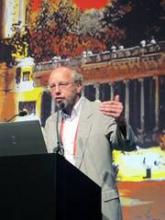MADRID – Patients with early, active rheumatoid arthritis who took tocilizumab – either alone or in combination with methotrexate – continued to benefit from it by the end of a 2-year study.
About half of those on either treatment strategy in the study achieved remission by the end of the first year and this did not change appreciably by the end of the second year. There was also a very low rate of radiographic progression, Dr. Tom Huizinga said at the annual European Congress of Rheumatology.
The results confirm and extend the earlier findings of ACT-RAY, a 2-year, randomized, placebo-controlled study of tocilizumab employed as a switch or add-on therapy for patients with early, active rheumatoid arthritis (RA). The 24-week data, published earlier this year, showed that tocilizumab was just as effective without methotrexate as with it, suggesting that it could be employed as monotherapy (Ann. Rheum. Dis. 2013;72:43-50).
All 553 patients in ACT-RAY received open-label tocilizumab 8 mg/kg intravenously every 4 weeks. They were randomized to the switch strategy (tocilizumab 8 mg/kg IV every 4 weeks with oral placebo) or the add-on strategy (tocilizumab 8 mg/kg IV every 4 weeks plus 2.5 mg methotrexate), said Dr. Huizinga, head of the department of rheumatology at Leiden (The Netherlands) University Medical Center.
Most of the patients (81%) were women; mean age was 53 years. Patients had a mean disease duration of 8 years and a mean Disease Activity Score–28 (DAS28) of 6.4.
Most of the study group (433) completed the second year of treatment. Reasons for withdrawal included lack of efficacy (2% in the add-on strategy group and 5% in the switch strategy group) and adverse events (10% of add-on patients and 11% of switch). There were three deaths in the add-on group and six in the switch group.
Sustained remission was defined as a DAS28 of less than 2.6 at two consecutive visits separated by 12 weeks. By week 52, about 50% of the overall cohort (53% add-on strategy and 47% switch strategy) had achieved remission and were able to discontinue tocilizumab.
By week 104, 86% of the overall cohort had experienced a flare in disease activity, with a median time of 90 days from tocilizumab discontinuation. Most of those patients restarted tocilizumab. The medication continued to be effective. The mean DAS28 at flare was 4.46, dropping to a mean of 2.99 within 4 weeks of restarting treatment.
The mean DAS28 score at week 104 was unchanged from the score at week 52, decreasing by 3.6 from baseline in both groups. The large majority of each group experienced no radiographic progression during year 2 (94% of the add-on and 91% of the switch groups).
By the end of the study at week 104, 23% of the add-on group and 18% of the switch group were in remission as measured by the Clinical Disease Activity Index – virtually identical to CDAI remission rates at week 52.
The safety results were consistent with previous findings, Dr. Huizinga said. Serious adverse events and infections occurred in 15% of the add-on group and 4% of the switch group.
Liver enzyme elevations were more common among those in the add-on group. Elevations of up to three times the upper limit of normal of alanine aminotransferase occurred in 58% of the add-on group and 40% of the switch group. Elevations of up to five times the upper limit occurred in 13% of the add-on group and 5% of the switch group. Aspartate transaminase elevations of up to three times the upper limit of normal occurred in 51% of the add-on group and 30% of the switch group. Elevations of up to five times the upper limit of normal occurred in 5% of the add-on and 2% of the switch groups.
During a discussion period after his presentation, Dr. Huizinga addressed the issue of clinical impact, saying all of the information isn’t in yet. Patients will be followed for an additional year for structural or joint damage.
"Clinical meaningfulness is an intense discussion that we will have to conduct," he said. "I’m not quite sure of it myself yet."
The study was funded by F. Hoffmann-La Roche Ltd. Dr. Huizinga disclosed that he is a consultant for Abbott, Axis Shield Diagnostics, Biotest AG, Bristol-Myers Squibb, Crescendo Bioscience, Roche, Novartis, Schering-Plough, UCB, Wyeth, and Pfizer.


